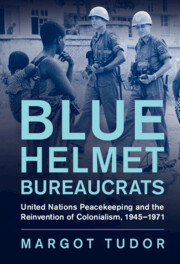97 results
4 - The United Nations II
-
- Book:
- International Organizations
- Published online:
- 17 May 2024
- Print publication:
- 06 June 2024, pp 76-99
-
- Chapter
- Export citation
2 - The Global Statesman
-
- Book:
- UN Mediators in Syria
- Published online:
- 16 May 2024
- Print publication:
- 23 May 2024, pp 35-90
-
- Chapter
- Export citation
3 - The UN Security Council: Between Centralism and Regionalism
-
-
- Book:
- The UN Security Council and the Maintenance of Peace in a Changing World
- Published online:
- 15 February 2024
- Print publication:
- 22 February 2024, pp 186-277
-
- Chapter
-
- You have access
- Open access
- HTML
- Export citation
Post-growth peacebuilding
-
- Journal:
- Review of International Studies , First View
- Published online by Cambridge University Press:
- 15 February 2024, pp. 1-11
-
- Article
- Export citation
7 - Operationalising Distinction in South Sudan
-
-
- Book:
- Civility, Barbarism and the Evolution of International Humanitarian Law
- Published online:
- 11 January 2024
- Print publication:
- 01 February 2024, pp 135-155
-
- Chapter
- Export citation
5 - The Use of Force in the UN Collective Security System: Maintenance and Restoration of International Peace and Security through Collective Measures
- from Part II - Scope and Content of the Contemporary jus ad bellum
-
- Book:
- The Use of Force and the International Legal System
- Published online:
- 07 December 2023
- Print publication:
- 21 December 2023, pp 74-93
-
- Chapter
- Export citation
3 - Warriors Who Don’t Fight
-
- Book:
- Uncertain Warriors
- Published online:
- 19 October 2023
- Print publication:
- 09 November 2023, pp 101-138
-
- Chapter
- Export citation
Nation branding and feminist diplomacy after crisis: France’s response to SEA allegations in Central African Republic – ERRATUM
-
- Journal:
- European Journal of International Security / Volume 9 / Issue 2 / May 2024
- Published online by Cambridge University Press:
- 06 November 2023, p. 299
- Print publication:
- May 2024
-
- Article
-
- You have access
- Open access
- HTML
- Export citation
9 - Sanctions, Countermeasures, and Collective Security
- from Part I - The Structure of International Law
-
- Book:
- International Law
- Published online:
- 19 October 2023
- Print publication:
- 02 November 2023, pp 180-198
-
- Chapter
- Export citation
Agents, multilateral institutions, and fundamental institutional change in international society: The case of Russia’s peacekeeping policy
-
- Journal:
- European Journal of International Security / Volume 9 / Issue 1 / February 2024
- Published online by Cambridge University Press:
- 18 October 2023, pp. 78-96
- Print publication:
- February 2024
-
- Article
- Export citation
Nation branding and feminist diplomacy after crisis: France’s response to SEA allegations in Central African Republic
-
- Journal:
- European Journal of International Security / Volume 9 / Issue 2 / May 2024
- Published online by Cambridge University Press:
- 14 September 2023, pp. 281-298
- Print publication:
- May 2024
-
- Article
-
- You have access
- Open access
- HTML
- Export citation
The Effect of Biased Peacekeepers on Building Trust
-
- Journal:
- Journal of Experimental Political Science / Volume 10 / Issue 3 / Winter 2023
- Published online by Cambridge University Press:
- 08 June 2023, pp. 426-437
-
- Article
- Export citation
5 - From Stagnation to Insignificance, 1964–1971
-
- Book:
- Blue Helmet Bureaucrats
- Published online:
- 20 April 2023
- Print publication:
- 27 April 2023, pp 214-258
-
- Chapter
- Export citation
3 - Imperial Aspirations, 1960–1961
-
- Book:
- Blue Helmet Bureaucrats
- Published online:
- 20 April 2023
- Print publication:
- 27 April 2023, pp 114-161
-
- Chapter
- Export citation
1 - Testing the Waters, 1945–1955
-
- Book:
- Blue Helmet Bureaucrats
- Published online:
- 20 April 2023
- Print publication:
- 27 April 2023, pp 30-76
-
- Chapter
- Export citation
Conclusion
-
- Book:
- Blue Helmet Bureaucrats
- Published online:
- 20 April 2023
- Print publication:
- 27 April 2023, pp 259-268
-
- Chapter
- Export citation
Introduction
-
- Book:
- Blue Helmet Bureaucrats
- Published online:
- 20 April 2023
- Print publication:
- 27 April 2023, pp 1-29
-
- Chapter
- Export citation
4 - Obstructing Self-Determination, 1962–1963
-
- Book:
- Blue Helmet Bureaucrats
- Published online:
- 20 April 2023
- Print publication:
- 27 April 2023, pp 162-213
-
- Chapter
- Export citation
2 - Reckoning with Suez, 1956–1959
-
- Book:
- Blue Helmet Bureaucrats
- Published online:
- 20 April 2023
- Print publication:
- 27 April 2023, pp 77-113
-
- Chapter
- Export citation

Blue Helmet Bureaucrats
- United Nations Peacekeeping and the Reinvention of Colonialism, 1945–1971
-
- Published online:
- 20 April 2023
- Print publication:
- 27 April 2023



